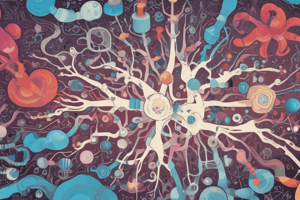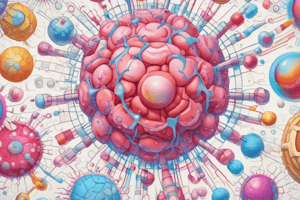Podcast
Questions and Answers
Which type of antiviral agents are commonly used to treat chronic hepatitis B caused by DNA viruses?
Which type of antiviral agents are commonly used to treat chronic hepatitis B caused by DNA viruses?
What type of antiviral drugs are effective against HIV infection caused by RNA viruses?
What type of antiviral drugs are effective against HIV infection caused by RNA viruses?
Which category of antiviral agents is specifically recommended for influenza infections?
Which category of antiviral agents is specifically recommended for influenza infections?
What is the main antiviral drug class used to combat Herpesvirus infections?
What is the main antiviral drug class used to combat Herpesvirus infections?
Signup and view all the answers
Which type of drugs are primarily used against Cytomegalous virus infections?
Which type of drugs are primarily used against Cytomegalous virus infections?
Signup and view all the answers
In treating Chronic Hepatitis C caused by RNA viruses, which type of antiviral agents are commonly employed?
In treating Chronic Hepatitis C caused by RNA viruses, which type of antiviral agents are commonly employed?
Signup and view all the answers
What is the main enzyme responsible for synthesizing viral DNA from RNA in retroviruses?
What is the main enzyme responsible for synthesizing viral DNA from RNA in retroviruses?
Signup and view all the answers
Which type of virus is responsible for some forms of cancer and AIDS?
Which type of virus is responsible for some forms of cancer and AIDS?
Signup and view all the answers
What is the key structural difference between aciclovir and deoxyguanosine?
What is the key structural difference between aciclovir and deoxyguanosine?
Signup and view all the answers
Why is aciclovir considered a prodrug?
Why is aciclovir considered a prodrug?
Signup and view all the answers
What is the primary target of aciclovir within the viral replication process?
What is the primary target of aciclovir within the viral replication process?
Signup and view all the answers
What is the key advantage of nucleoside analogues as therapeutic agents?
What is the key advantage of nucleoside analogues as therapeutic agents?
Signup and view all the answers
What is the specific role of thymidine kinase in the activation of aciclovir?
What is the specific role of thymidine kinase in the activation of aciclovir?
Signup and view all the answers
What is the effect of valine substitution in the prodrug strategy involving aciclovir?
What is the effect of valine substitution in the prodrug strategy involving aciclovir?
Signup and view all the answers
How does Cidofovir address the issue of viruses lacking thymidine kinase?
How does Cidofovir address the issue of viruses lacking thymidine kinase?
Signup and view all the answers
Which enzyme is 100 times more efficient in making the monophosphate of aciclovir compared to host cells?
Which enzyme is 100 times more efficient in making the monophosphate of aciclovir compared to host cells?
Signup and view all the answers
What makes Cidofovir an effective treatment for viruses lacking thymidine kinase?
What makes Cidofovir an effective treatment for viruses lacking thymidine kinase?
Signup and view all the answers
In what way does famciclovir differ from penciclovir?
In what way does famciclovir differ from penciclovir?
Signup and view all the answers
How does valganciclovir enhance bioavailability compared to ganciclovir?
How does valganciclovir enhance bioavailability compared to ganciclovir?
Signup and view all the answers
What characterizes nucleoside analogues concerning their mechanism of action?
What characterizes nucleoside analogues concerning their mechanism of action?
Signup and view all the answers
What role does the 3’ carbon hydroxyl motif play in DNA replication?
What role does the 3’ carbon hydroxyl motif play in DNA replication?
Signup and view all the answers
Why is acetylation used as a strategy for nucleotide analogues?
Why is acetylation used as a strategy for nucleotide analogues?
Signup and view all the answers
Study Notes
Nucleoside Analogues
- Lack of hydroxyl motif at the 3' carbon of the sugar ring, required to form a 3'–5' phosphodiester bond with the next nucleoside substrate in the elongating DNA strand.
- Chain termination occurs on incorporation of the nucleoside analogue into the nascent, elongating primer strand of DNA.
Aciclovir
- Selective for the virus due to conversion to the triphosphate active form only in infected cells.
- In uninfected cells, aciclovir remains as the inactive prodrug.
- Selective uptake of aciclovir into infected cells.
- Aciclovir triphosphate has 50-fold selectivity for viral DNA polymerase.
- Phosphorylation is activated by the enzyme thymidine kinase.
- Viral enzyme is 100 times more efficient than host cell at making the monophosphate of aciclovir.
Bioavailability of Aciclovir
- Oral bioavailability of aciclovir is quite low, 15-30%.
- Prodrug strategies were developed to increase water solubility.
- Valaciclovir was the first effort to enhance bioavailability.
- Esters of aciclovir absorb from the gut faster than aciclovir.
- L-valine allows the prodrug to be recognized by transport proteins.
- Once absorbed, hydrolyzed to aciclovir in liver and gut wall.
Other Aciclovir-Like Prodrugs
- Desciclovir is a prodrug where C=O of purine is missing.
- Has increased water solubility.
- When in blood, xanthine oxidase oxidizes to the 6-position to give aciclovir.
- Ganciclovir is an analogue with an extra hydroxymethylene group.
- Valganciclovir is the corresponding prodrug.
- Acetylation reduces polarity and increases absorption.
- Oxidation in liver gives the active form.
- Penciclovir is an aciclovir analogue where the ring oxygen is replaced by CH2.
- Famciclovir is the corresponding acetylated prodrug.
- Subsequent phosphorylation then generates the active form.
Absence of Thymidine Kinase
- Some viruses do not contain a viral thymidine kinase.
- Result is that they are not affected by aciclovir and its analogues.
- Cidofovir was designed to combat this issue.
- It is an analogue of deoxycytidine 5-monophosphate.
- Cytosine base unchanged.
- Sugar replaced by acyclic group.
- Phosphate replaced by phosphonomethylene group.
- Acts as a bioisostere, avoiding enzymatic hydrolysis of a phosphate group.
- Does not require a thymidine kinase to phosphorylate it to activate.
- Two further phosphorylations by cellular kinases give the active form.
Summary of Nucleoside Analogues
- Nucleoside analogues are active against DNA viruses, e.g., herpes viruses.
- They are prodrugs as they need phosphorylation to be active.
- Dual MOA: chain terminators and inhibitors.
- Aciclovir and its analogues show:
- Selectivity for virus-infected cells over healthy normal cells.
- Corresponding triphosphate selective for viral DNA polymerases.
- Drugs with phosphate bioisosteres are effective for viruses lacking thymidine kinase, e.g., Cidofovir.
- Other nucleotide analogues exist for DNA viruses, but issues of toxicity.
- Nucleoside and nucleotide analogues are also used for many other types of viral infections, namely Hepatitis and HIV.
Types of Viruses
- There are several types of viruses: RNA viruses, DNA viruses, retroviruses, and others.
- RNA viruses: RNA-virus replication occurs in the cytoplasm.
- DNA viruses: Viral mRNA formed in cell by viral DNA using host cell's polymerases.
- Viruses have different types of genomes, including single-stranded or double-stranded DNA or RNA.
Introduction to Antiviral Agents
- Many diseases are a result of DNA viruses, such as herpes virus infections, viral hepatitis, and others.
- Nucleoside analogues are effective therapeutic agents.
- Nucleotide triphosphates are the building blocks of DNA replication.
- DNA and RNA both include carbohydrate portions, containing the sugar pentose D-ribose.
- Purines and pyrimidines are components of nucleosides and nucleotides.
Studying That Suits You
Use AI to generate personalized quizzes and flashcards to suit your learning preferences.
Description
Test your knowledge on antiviral agents for DNA viruses, focusing on topics such as chronic hepatitis B, chronic hepatitis C, and herpesvirus infections. This quiz covers nucleoside analogues, nucleotide analogues, interferons, non-structural protein SA inhibitors, and more.




